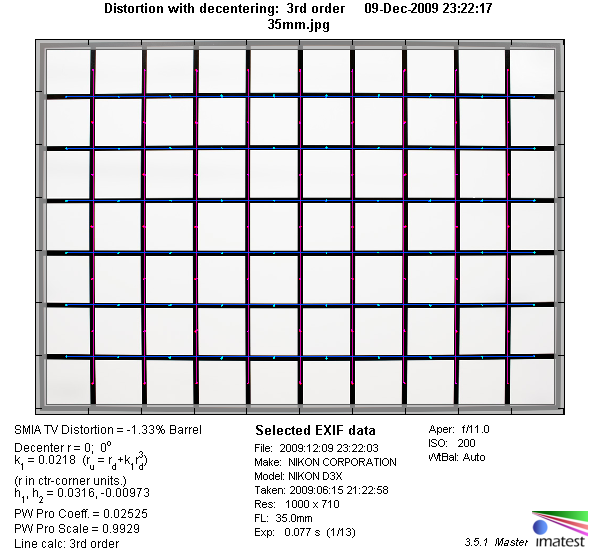|
Page 2 of 3

Distortion
The lens shows moderate barrel distortion at around 1.3%. This can be visible and disturbing for subjects with straight lines near the image border. However, the distortion is uniform and thus easy to remove in post processing.

The chart above has a real-world size of about 120x80cm.
Vignetting
Typical for most fast primes the lens shows visible vignetting, reaching almost 1.5 EV wide open. There's a moderate level of vignetting left at f/2.8 which is reduced further to a negligible degree stopped down to f/4.0 and beyond.
We're performing our vignetting analysis based on
(uncorrected) JPEGs straight from the camera. The JPG engine of the Nikon D3x features a rather flat
gradation curve, thus has a moderate contrast characteristic, resulting in comparatively low vignetting figures - the
corresponding Canon figures are roughly 40% higher due to the more
aggressive default contrast setting.

MTF (resolution)
The lens delivers very good sharpness in the image center wide open and at f/2.8, stopping down to f/4 and beyond increases the resolution figures to excellent levels.
Borders and extreme corners are a very different story, though. Somewhat soft wide open, the resolution surprisingly decreases at f/2.8. Stopping down further increases the resolution again, by f/8 both borders and corners even reach very good sharpness.
At all tested apertures the extreme corners deliver higher resolution figures than the borders.
The lens showed some focus shift when stopping down (residual spherical aberration).
Please note that the MTF results are not directly comparable across the different systems!
Below is a simplified summary of the formal findings. The chart shows line widths
per picture height (LW/PH) which can be taken as a measure for sharpness.
If you want to know more about the MTF50 figures you may check out the corresponding
Imatest Explanations

Chromatic Aberrations (CAs)
Chromatic aberrations (color shadows at harsh contrast transitions) are in the range of roughly 0.9 to almost 1.5 pixels, reaching the highest values stopped down do f/11. Given the huge resolution of the test camera, this might be visible in very large prints (or heavy crops), however, for typical print sizes the problem isn't really relevant for most subjects. In addition, CAs can easily be corrected in software or by the camera itself.

Bokeh
The quality of the bokeh (out-of-focus blur) is a little disappointing. Good news first: in front of the focal plane the bokeh shows very pleasant blur. However, for a wide angle lens this is probably a completely irrelevant property in the field. In the transition zone and behind the focal plane the lens produces double images and nervous blur.
Background highlights are troubled by very pronounced outlining wide open, stopping down helps to reduce this issue. However, from f/5.6 onwards the straight aperture blades form polygon highlights instead of circles.

Bokeh Fringing / Longitudinal Chromatic Aberrations (LoCA)
LoCAs (non-coinciding focal planes of the various colors) are a common issue with relatively fast glass. As you can
notice below the halos have different colors - magenta (red + blue) in front the focus point
and green beyond. Truly "apochromatic" lenses don't show LoCAs but these lenses are very rare especially
below 100mm. Unlike lateral lateral CAs, LoCAs cannot easily be fixed in post processing.
The AF-D 35/2.0 shows a moderate amount of LoCAs at large aperture settings, stopping down helps to reduce the issue to a negligible degree.
In addition, these shots also show the focus shift when stopping down and demonstrate the lack of contrast and sharpness wide open (the latter being emphasized on short subject distances).
|